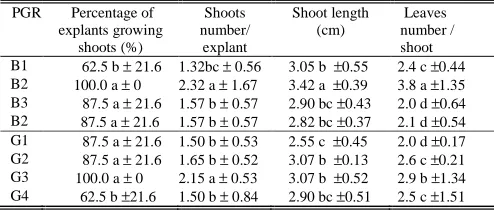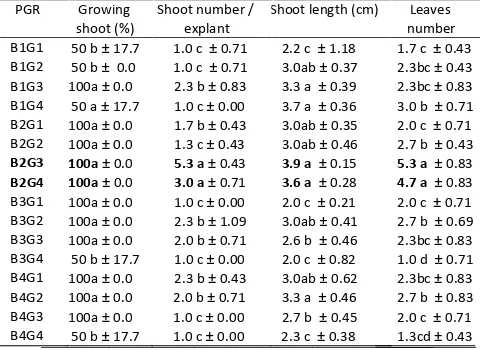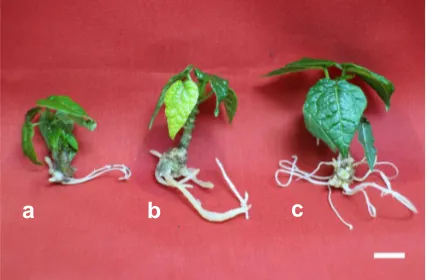The 5 International Conference on Global Resource Conservation
February 12-13
2014
24
|
Batu, East Java, Indonesia
C
Abstract—An efficient micropropagation protocol in Carica pubescens Lenne & K. Koch known as an endemic
species at Dieng highland and has a great commercial importance has been developed. In the present study the influence of growth regulator of culture medium on shoot multiplication and rooting induction was investigated. For shoot multiplication, lateral shoot explant was chosen. The research was carried out using a completely randomized factorial design with two factors. Different concentrations of 6-benzylamino purine (BAP) (1.0, 2.0, 3.0 and 4.0 µM) and gibberelic acid-3 (GA3) (0.1, 0.2, 0.3, and 0.4 µM) were added to Murashige and Skoog (MS) medium. The best shoot multiplication was showed on MS medium containing 2.0 µM of BAP and 0.3 µM of GA3. After 3 months of culture shoot initiation has been observed in all explants with 5.3 number of shoot per explant, and 3.9 cm shoot height. Further shoot multiplication in successive subcultures was also possible. For rooting induction, the research was conducted using a completely randomized design with one factor. Medium MS supplemented with 2 ppm (9.8 µM) of 3-indolebutyric acid (IBA) proved to be the best one for rooting of shoots, producing root initiation at 16 days after rooting, 4.50 number of roots per shoot and 7.57 cm root length. This protocol opens up the prospect of in vitro conservation of this endemic species.
Keywords—Carica pubescens, Root Induction, Shoot
multiplication,
I. INTRODUCTION
arica pubescens Lenne & K. Koch (syn. Vasconcellea pubescens) belongs to the Caricaceae.
Currently, only about 33 thousands of C. pubescens plants were cultivated in Dieng (private communication with district government of Wonosobo, Central of Java, 2011), mainly concentrated at altitude of 2400 m above sea level like Sembungan and Sikunang village. These villages are few areas where C. pubescens could grow well and bears fruit optimally with a high antioxidant capacity [1]. C. pubescens possesses great economic potential due to their benefits as food and medicine materials. Its habitus is similar to C. papaya but the fruits are smaller than it (Fig. 1a) and have a strong characteristic flavor. The fruit mainly used to produce preserved fruit. An additional feature of this species is its ability to produce latex with a high level of papain, an important and valuable proteolytic enzyme in
industrial and pharmaceutical [2].
Because of the economic potential and associated with its extensive usability, germplasm preservation is important strategy to guarantee not only the conservation, but also their sustainable use. In vitro conservation needs a large quantity of
shoots which can be induced to form roots.
This study aims to develop in vitro shoot multiplication and root induction protocol of C.
pubescens. The multiplication of shoot and induction of
root are greatly influenced by plant growth regulators content in the medium. Increase in volume associated with shoot multiplication and adventitious root growth must be the result of either cell division or cell enlargement, or both. Cytokinin was believed as division cell regulator and auxin known to be involved in cell enlargement. The requirement of type and concentration of each of plant growth regulator varies with different species [3]. Previous study showed that addition of auxin and cytokinin into Murashige and Skoog (MS) (1962) medium was not effective in shoot multiplication of C. pubescens (data no shown). Therefore, this study would examine the use of gibberellins (especially gibberelic acid-3 or GA3), and cytokinin (especially 6-benzylamino purine or BAP) in inducing shoot multiplication. The roles of GA3 related to photomorphogenesis are in stem elongation and leaf differentiation [3].
Auxin has been recognized as a controlling factor in rooting induction since a long time [4]. Of the several types of synthetic auxin, indole butyric acid (IBA) was more effective for producing roots of woody plants than the others [5].
II. MATERIALS AND METHODS
Shoot multiplication
The objectives of this step study were to examine the effects of BAP and GA3 supplementing into MS medium on shoot multiplication of C. pubescensand and to determine the concentration of BAP and GA3 capable of proliferating shoot maximally.
Shoot Multiplication and Rooting Induction
in Carica pubescens Lenne & K. Koch
(Mountain Papaja)
Enni S. Rahayu
1*), Noor A. Habibah
1)Mufidah H. Noviana
1) 1)Department of Biology, Faculty of Mathematic and Sciences,
Semarang State University (Unnes), Semarang, Indonesia
*)
February 12-13
2014
The 5 International Conference on Global Resource Conservation number and characteristics of fruits. The shoot explants were washed with soft detergent and tap water, followed by 3-4 rinses with distilled water. To prevent browning, the explants were soaked in 150 ppm ascorbic acid solution, and then soaked in 70% alcohol for 3 minutes. The surface disinfectant of explants was accomplished by dipping explants in 6% (v/v) solution of commercial bleach for 15-20 minutes with 0.1% tween 20. Afterwards, the explants were rinsed five times with autoclaved distilled water under a laminar air flow (LAF) cabinet which had been sterilized by UV irradiation for 30 minutes and spraying 70% alcohol. Before planting in the multiplication medium, sterile explants were grown on MS medium without growth regulators to control contamination for 4 days, and then transferred to a basal medium, that was MS mediumsupplemented with 2µM BAP, 0.5µM IBA
and0.3µ MGA3.
Effects of adding concentration of BAP and GA3 in the MS medium on growth and multiplication of C.
pubescens shoot were carried out in a completely
randomized factorial design experiment with two factors, that were concentration of BAP and GA3. Each of the experimental unit consisted of two shoots, cultured in one culture vial (Fig. 1b). Four replicates were prepared for each combination of the BAP and GA3 concentration.
The explants were, aseptically, placed on agar-solidified MS medium containing 3% sucrose varied in plant growth regulators combinations. MS medium were supplemented with a combination of BAP and GA3 at concentrations of 1.0, 2.0, 3.0, and 4.0 µM and 0.1, 0.2, 0.3 and 0.4 µM, respectively. All media were adjusted to pH 5.8 at 25°C with KOH and HCl and were autoclaved for 20 minutes at 121°C (15 PSI nominal steam pressure) after the addition of growth regulators as required. As much as 25 ml medium was poured into each of the culture vial. The cultures were incubated in a 24 h light at 15 ± 2°C and were illuminated with fluorescent light at 1000 lux. The explants were cultured in each for a total of three months period, and were transferred onto fresh medium every month.
Shoot multiplication responses recorded were percentage of explants growing shoots, number of axillary shoots formed from explant, shoot length (cm), and number of leaves per shoot. Data were statistically analyzed in a completely randomized design with four replicates. The data were analyzed by Analysis of Variance and Duncan's multiple ranges test (DMRT) using SAS statistical analysis program System for Windows 9.0.
Root Induction
The aims of this second step study were to examine the effect of IBA supplementing into MS medium on root induction of C. pubescens and to determine IBA concentration capable of inducing root maximally.
Effects of IBA supplementing into MS medium on root induction was carried out in a completely randomized design experiment with one factor, that was concentration of IBA. Each of the experimental unit consisted of one shoot, cultured in one culture vial. Eight replicates were prepared for each of the IBA concentration. To induce roots from the selected shoots, all regenerated shoots (2-3 cm in height and with 1-2 were statistically analyzed in a completely randomized design with four replicates. The data were analyzed by Analysis of Variance and DMRT using SAS statistical analysis program System for Windows 9.0
III. RESULTS AND DISCUSSION induction (87.5-100%). The maximum shoot number per explant, shoot length and leaf number per shoot were observed at 2 µM BAP. The medium supplemented with BAP more than 2 uM inhibited shoot multiplications (Tab. 1). The inhibition of shoot multiplication was in line to the result obtained in
Phaseolus angularis that its bud growth and shoot
multiplication were stimulated by reducing the BAP concentrations from 5.0 to 2.5 µM after 3 weeks [6].
Cytokinins have been proved to overcome apical dominance, release lateral buds from dormancy and promote shoot formation [3]. Stimulation of multiple shoot formation by BAP has been reported in several plant species, including Ocimum basilicum [7], Galax
urceolata [8], and Aloe vera [9].
TABLE 1
EFFECT OF PLANT GROWTH REGULATORS (BAP AND GA3 ALONE) ADDED INTO MS MEDIUM ON
SHOOT MULTIPLICATION OF C. pubescens
•
Data represent mean ± standard error of two explants per treatmentThe 5 International Conference on Global Resource Conservation
February 12-13
2014
26
|
Batu, East Java, Indonesia
followed by the same letter are not significantly different according to DMRT at p = 0.05 multiplication (87.5-100%). The maximum shoots number per explant and leaves number per shoot were observed at 0.3 µM GA3 (Tab. 1). Gibberelins have showed a broad spectrum of physiological effect in plants. Because of their role in cell wall formation and cell expansion they involved in dormancy breakage [10], lateral branching and young leaf growth [11]. This result was in accord with finding from previous study on
Lotus corniculatus L. [12]. concentration, the growth will be inhibited [3].
Of the 16 combinations of BAP and GA3 tested, the combination of BAP 2 µ M + GA3 0.3 µM and BAP 2 µM + GA3 0.4 µM-treated explants achieved highest regeneration than those other combinations. The two
combinations of treatments yielded maximum
regeneration (100%) and maximum number of multiple shoots (3.0-5.3 shoots per explant). Shoots developed in this medium also were longest (3.6-3.9 cm) and generated maximum number of leaves (4.7- 5.3 (Tab. 2, Fig. 1c).
TABLE 2
EFFECT OF GROWTH REGULATORS (BAP AND GA3 COMBINATION) ADDED INTO MS MEDIUM ON SHOOT
MULTIPLICATION OF C. pubescens
•
Data represent mean ± standard error of two explants per treatment in four replicated experiments. Means within a single column followed by the same letter are not significantly different according to DMRT at p= 0.05 shoot multiplication. (a) A C. pubescens plant grown at Dieng. Bar = 15 cm (b) Two explants after cultured on multiplication medium for 1 month. Bar = 0.7 cm. (c) High rate of shoot multiplication on MS medium supplemented with BAP 2 µM + GA3 0,3 µM after cultured 3 months. Bar = 0.5 cm.Previous finding have also indicated the role of BAP and GA3 in Rosa shoot multiplication. The highest multiplication rate of R. canina and R. rubiginosa (4.1 shoots per one explant) and R. dumalis (2.9 shoots per one explant) was obtained when shoots were multiplied on an MS medium supplemented with 1 µM BA and 1.5
µM GA3 [13].
Although it was difficult to quantify healthy of shoot but we have observed that shoots obtained from explant cultured in MS medium supplemented with the optimally concentrations of cytokinin and gibberelin (BAP 2 µM + GA3 0.3 µM or BAP 2 µM + GA3 0.4 µM) were generally healthier (better vigor) than those obtained from the other concentrations. This indicates that multiplication response depends upon the type and concentration of plant growth regulator used.
Root Induction
Elongated shoots (3–4 cm) were excised and placed on full-strength MS medium supplemented with various concentrations of IBA for induction of roots. These media gave developed roots within 16–30 days. Application of IBA at 2 ppm resulted fastest rooting than the higher concentration (Tab. 3). Supplementing of IBA at 2 ppm into MS medium might have triggered the early anticlinal cell division and root primordia formation than higher concentration [14].
TABLE 3
EFFECT OF IBA CONCENTRATIONS
IN MS MEDIUM ON ROOTING INDUCTION OF C. pubescens IBA Data represent mean ± standard error of one explant per treatment in eight replicated experiments. Means within a single column followed by the same letter are not significantly different according to DMRT at p= 0.05
February 12-13
2014
The 5 International Conference on Global Resource ConservationBatu, East Java, Indonesia
|
27
and 8 ppm IBA, but in medium containing 2 ppm IBAthe number of roots was highest (4.50) The greater IBA concentration, the lower number of roots (Tab. 3, Fig. 2). The result showed that auxin is essential to induce rooting in the C. pubescens microcutting as no rooting was observed in the absence of IBA (data not shown).
IBA produced the longest roots (7.57 cm) also at concentration of 2 ppm (Tab. 3, Fig. 2). The results also revealed that root length tend to reduce with higher than
optimum concentration of IBA. Like other
developmental processes, root cell elongation involves sequential changes in levels and/or activity of enzymes. The enzymes involved in cell enlargement processes are triggered by the auxin [3].
Indole-3-acetic acid (IAA) is the most abundant naturally or endogenous auxin and IBA is classified as a synthetic auxin [3]. Process of root formation in cuttings involves the activity of peroxidase, IAA oxidase, and phenolics [15]. Exogenous IBA induce changes in activities of peroxidase and IAA oxidase and in contents of phenolics allowing the establishment of the favourable endogenous hormone balance. The metabolism of the exogenous IBA, especially its combination with phenolic compounds, has been considered in relation to the promotion of adventitious rooting [16]. higher level of degradative metabolites in tissues which blocking the regeneration process [19]. Besides these, specific exogenous IBA to endogenous IAA ratio may be important for plant development [20], and the application of exogenous IBA of 2 ppm might shift the balance to promote root development of C. pubescens.
The stimulatory effect of IBA of root formation has been reported in many other plant species. Exogenous IBA had a significant positive effect on the rooting responses of woody plants such as date palm [21], apple [22], and olive cultivar ‘Moraiolo’ [23]. and root length. This protocol can be used to regenerate a large number of rooting shoots as materials of C.
pubescens in vitro conservation.
REFERENCES
[1] A.N. Laily, Sunarto, and Sugiarto, “Characterization of Carica pubescens in Dieng Plateau, Central of Java based on morphology, antioxidant capacity and protein binding pattern,”
Bioscience, vol. 4, no. 1, pp. 16-21, March 2012.
[2] B. Carrasco, P. Avilla, J. Prez-Diaz, P. Munoz, R. Garcia, B. Lavandero, A. Zurita-Silva, J.B. Retamales, and P.D.S. Caligari, “Genetic structure of highland papayas (Vasconcellea pubescens (Lenne ́ et C. Koch) Badillo) cultivated along a geographic gradient in Chile as revealed by Inter Simple Sequence Repeats (ISSR),” Genet Resour Crop Evol, vol. 56, pp. 331–337, August 2008.
[3] L. Taiz and E. Zeiger, “Plant Physiology” 5th
ed., Sunderland, Massachusetts, USA: Sinauer Associates Inc., Publishers, 2010, ch. 19, 20, 21.
[4] E. Tanimoto, “Regulation of root growth by plant hormones: Roles for auxin and Gibberellin,” Crit. Rev. Pl. Sci., vol. 24, no. 4, pp. 249-265, 2005.
[5] J. Wynne and M.S. McDonald, “Adventitious root formation in woody plant tissue: The influence of light and indole-3-butyric acid,” In vitro Cell Dev. Biol., vol. 38, no. 2, pp. 210-212, 2002. [6] S.V. Mohamed, J-M. Sung, T-L Jeng, C-S Wang,
“Organogenesis of Phaseolus angularis L.: high efficiency of adventitious shoot regeneration from etiolated seedlings in the presence of N6-benzylaminopurine and thidiazuron,” Plant Cell
Tiss Organ Cult, vol. 86, pp. 187–199. July 2006.
[7] S. Saha, T. Dey, and P. Ghosh, “Micropropagation of Ocimum
kilimandscharicum Guerke (Labiatae),” Acta Biologica
Cracoviensia Series Botanica, vol. 52, no. 2, pp. 50–58, 2010.
[8] G. Yang, X. Shen, R. Jackson, and Z. (C) Lu, “Factors affecting
in vitro seed germination and shoot proliferation of galax [Galax urceolata (Poir.) Brummitt]”. Aust. J. Crop Sci. vol. 7, no. 11,
pp. 1766-1771, 2013.
[9] S. Zakia, N.J. Zahid, M. Yaseen, N.A. Abbasi, A.A. Hafiz and N. Mahmood, “Standardization of micropropgation techniques for Aloe vera: A pharmaceutically important plant,” Pak. J.
Pharm. Sci., vol.26, no.6, pp.1083-1087, Nov. 2013.
[10] A.K. Huttly & A.L. Phillips, “Gibberellin-regulated plant genes,” Physiol. Plant., vol. 95, pp. 310–317, 1995.
[11] C.M Fleet and T. Sun, “A DELLAcate balance: the role of gibberellin in plant morphogenesis,” Current Opinion in Plant
Bio., vol. l, 8, pp. 77–85, 2005.
[12] R. Nikolic, N. Mitic, S. Ninkovic , B. Vinterhalter, S. Zdravkovic ́-Korac, and M. Nesˇkovic ́, “Gibberellic acid promotes in vitro regeneration and shoot multiplication in Lotus
corniculatus L.,” Plant Growth Regul, vol. 62, pp. 181–188, development,” Plant Growth Reg., vol. 32, no. 2-3, pp. 219-230, 2000.
[15] E. Caboni, M.G. Tonelli, P. Lauri, P. Iacovacci, C. Kervers, C. Damiano, and T. Gaspar, “Biochemical aspects of almond microcuttings related to in vitro rooting ability,” Biologia Plant, vol. 39, pp. 91-97, 1997.
[16] A. Qaddoury and M. Amssa, “Effect of exogenous indole butyric acid on root formation and peroxidase and indole-3-acetic acid oxidase activities and phenolic contents in date Palm offshoots,”
Bot. Bull. Acad, Syn . vol. 45, pp. 127-131, 2004.
[17] M. Kollmeier, H.H. Felle and W.J. Horst, “Is basipetal auxin flow involved in inhibition of root elongation,” Pl. Physiol., vol.
c
b
The 5 International Conference on Global Resource Conservation
February 12-13
2014
28
|
Batu, East Java, Indonesia
122, pp. 945-956, 2000.[18] J.F. Hausman, “Changes in peroxidase activity, auxin level and ethylene production during root formation by poplar shoots raised,” In vitro. Plant Growth Reg., vol. 13, no. 3, pp. 263-268, 2003.
[19] C.M. Baker and H.Y. Wetzstein, “Influence of auxin type and concentration on peanut somatic embryogenesis,” Plant Cell
Tiss. Organ Cult., vol. 36, no. 3, pp. 361-368, 2004.
[20] E. Epstein and J. Ludwig-Mu ̈ller, “Indole-3-butyric acid in plants: occurrence, synthesis, metabolism, and transport,”
Physiol. Plant, vol. 88, pp. 382–389. 1993.
[21] A. Qaddoury and M. Amssa, “Effect of exogenous indole butyric acid on root formation and peroxidase and indole-3-acetic acid oxidase activities and phenolic contents in date Palm offshoots,”
Bot. Bull. Acad, Syn., vol. 45, pp. 127-131, 2004
[22] T. Sharma, M. Modgil, and M. Thakur, “Factors affecting induction and development of in vitro rooting in apple rootstock”, Indian J. of Exp. Biology. Vol 45, pp 824-829, Sept. 2007.


